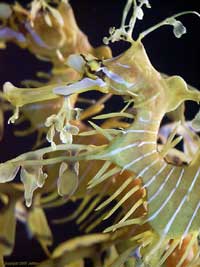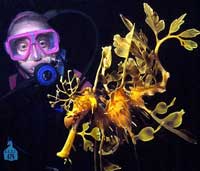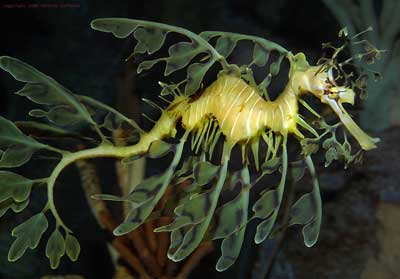 If we claim that dragons do not exist in this world, it may not be entirely accurate. Just one glimpse of the Phycodurus eques will convince many that dragons are real, although they are not the fire-breathing creatures of mythology, but rather a creature resembling a dragon in a smaller size.
If we claim that dragons do not exist in this world, it may not be entirely accurate. Just one glimpse of the Phycodurus eques will convince many that dragons are real, although they are not the fire-breathing creatures of mythology, but rather a creature resembling a dragon in a smaller size.
The Leafy Sea Dragon (Phycodurus eques) is one of the most beautiful and mysterious fish in the ocean.
The Leafy Sea Dragon is visually striking, resembling a branch adorned with peculiar leaves. These leaves are actually flaps of skin that hang throughout its head, body, and tail, making it look remarkably like real leaves.
These flaps do not aid the Leafy Sea Dragon in movement. In fact, the body of the Leafy Sea Dragon rarely appears to be in motion. Upon closer observation, you can see that the Leafy Sea Dragon mimics the swaying movement of kelp in the ocean, and only by looking very closely can you discern the faint small fins helping it to move.
In the animal kingdom, the Leafy Sea Dragon is one of the most evolved species in the art of camouflage. Predatory fish often find it difficult to recognize the Leafy Sea Dragon as a creature, as it closely resembles a vibrant plant. Throughout its life, the Leafy Sea Dragon leisurely swims among kelp, primarily of three types: Macrocystis, Ecklonia, and Lessonia.
Due to the absence of specialized swimming parts like other fish, although it bears the name “dragon”, this creature is actually a very weak swimmer. However, its tail is not prehensile (like a seahorse), and throughout its life, the Leafy Sea Dragon must continuously move, even if it does not swim far.
The life of the Leafy Sea Dragon is closely tied to underwater kelp forests, which is quite reasonable. With its leaf-like camouflage, it remains safe among the foliage. However, when separated from the plant world, it becomes more attractive to ordinary prey due to its unusual appearance and quickly becomes a tasty target for many larger fish.
In addition to its leafy appearance, the Phycodurus eques has a long and slender snout, primarily used to suck in small prey into its tiny mouth. The Leafy Sea Dragon’s favorite food consists of small, soft-bodied invertebrates that linger around the kelp forests.
 When defending itself or attacking, the Leafy Sea Dragon can curl up and extend its spikes – these spikes are its most important weapon, although in nature, few enemies target the Leafy Sea Dragon as a primary food source.
When defending itself or attacking, the Leafy Sea Dragon can curl up and extend its spikes – these spikes are its most important weapon, although in nature, few enemies target the Leafy Sea Dragon as a primary food source.
The reproductive method of the Leafy Sea Dragon is also quite peculiar. The female lays eggs once a year, producing about 250 eggs each time. The female transfers her eggs to the brood pouch located on the male’s tail. This brood pouch contains spongy material with numerous depressions, each designed to hold an egg (the eggs are fertilized during the transfer process). The male carries the eggs until they hatch. After about 8 weeks, the eggs hatch, but in nature, only about 5% of the eggs develop to maturity (around 2 years old).
Leafy Sea Dragons typically reside at depths ranging from 5 to 35 meters and are found exclusively in temperate waters (with temperatures ranging from 14-19°C year-round) along the southern coast of Australia, particularly in the kelp forests around Kangaroo Island and Lancelin.
Typically, Leafy Sea Dragons grow to approximately 35 cm in length, although they can occasionally reach lengths of up to 45 cm.
The Leafy Sea Dragon is protected by Australian law. Without strict protective measures, many Leafy Sea Dragons would be captured for sale to aquarium enthusiasts and collectors of exotic creatures. Additionally, the Chinese traditional medicine market has a high demand for this mysterious marine dragon.



















































